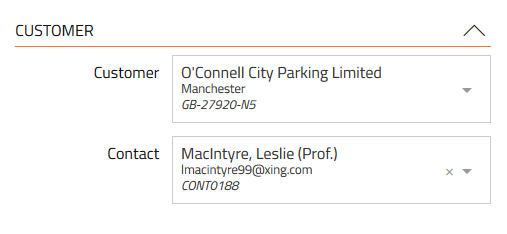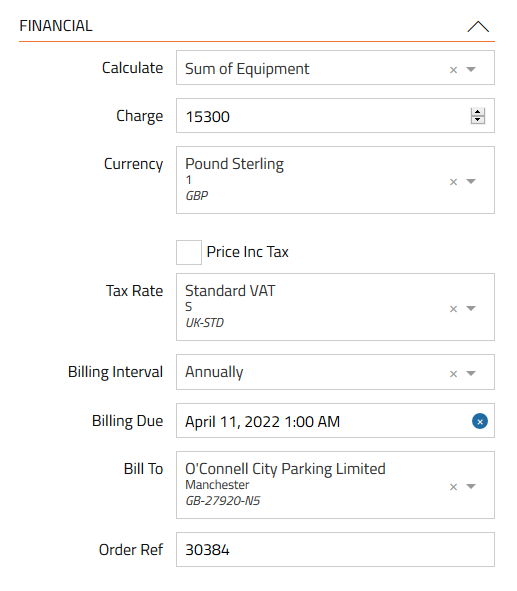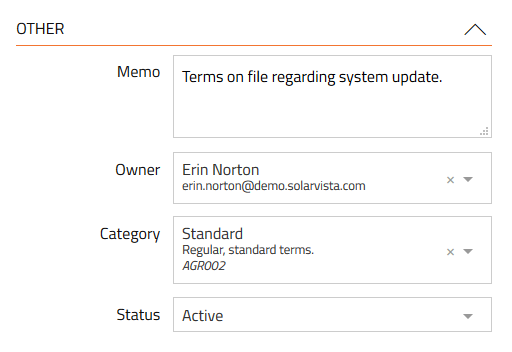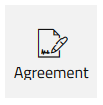Agreements
A detailed look at the fields and dependencies in the Agreements records, how to create a new Agreements record & editing existing Agreements.
![]()
Agreements are only available in the Standard
and Enterprise
versions of Solarvista. If you are using Lite
, please skip to Problems or return to Setting Up Data.
The “Agreement” record holds information about a contractual arrangement between you and a Customer. The information stored includes associated customer, validity dates, service level (sometimes referred to as “SLA”) and charges.

Agreements can have associated Equipment records; this is done by associating the Equipment record with an Agreement record, therefore the Agreement record must be setup prior to entering associated Equipment.
It is not mandatory to setup charges if you do not wish to use the billing feature. The Charge field holds the billing amount which is generated on an Invoice at the Billing Due Date. It will repeat based upon the Billing Interval. If you wish to use Equipment as a basis of the Charge, set the Calculate field to “Sum of Equipment.
When Jobs/Work Items are created, Solarvista will check for entitlement to prescribed service levels and set SLA if it finds an associated Agreement.
All Agreements must have the validity dates populated to become effective.
Where Agreement Records are Used
The following files refer to Agreement records so if you plan to use any of these, setting up the records in this file will be important or even critical:
Work Items:
- Generic Job
- Field Repair
- Internal Repair
- Depot Repair
- Installation
- Field Maintenance
- Internal Maintenance
- Survey
- Field Task
- Internal Task
- Help Desk Call
Data Sources:
- Equipment
- Recurring Work
- Invoice
Pre-requisite Files for Agreement Records
When setting up Agreement records, it is recommended to review the other data files that may need to be referred to by each record. These are the files that you may need to setup in advance:
- Customers
- Contacts
- Service Levels
- Pricing Policies
- Categories (Agreement)
- Tax Rates
- Currencies
- Products
Field Descriptions for Agreement Records
The ID section holds the unique ID for the record and a document reference for the “paper” contract if applicable:

Reference - holds the unique ID for the record (most records in Solarvista have one of these). It cannot contain any spaces or non-standard characters. Once the record is saved, it is not possible to edit it afterwards. In most default situations, the Reference is automatically set using a counter sequence, however, you can setup your own if you prefer.
Document Ref – holds a reference or ID of the “paper” (or alternative system) contract document, if applicable.
The Customer section holds information about the customer:

Customer – the Customer that the Agreement is with.
Contact – the Contact that is responsible for the Agreement. The Customer must be selected before this field can be populated.
The Details section holds detail about validity, service level and renewal status:

Start – the date when the Agreement starts.
End – the date when the Agreement ends or renews.
Renewal – how the Agreement should be renewed. At renewal, the dates are “rolled over” and billing occurs. The options are:
- Do not Auto Renew – the Agreement will not be renewed automatically.
- Automatically Renew – the Agreement will renew automatically at the End
Service Level – the Service Level ("SLA") definition for this Agreement. These must therefore be defined in advance.
Pricing Policy – when Work Items are created and registered for this Agreement, the Pricing Policy set here will be defaulted.
The Financial section holds information about the charges related to the Agreement:

Calculate – this sets the method of computing the Agreement charge:
- Use Charge – use the Charge field from the Agreement (manually entered).
- Use Sum of Equipment – sum the Charge fields from each linked Equipment record.
Charge– the charge to be made for the Agreement for the period defined in Billing Interval.
Currency – the currency that the Charge is denominated in.
Price Inc Tax – if checked, denotes that the Charge includes any taxes applicable.
Billing Interval – how often the amount in Charge field is billed.
Billing Due – the date when the next bill is due to be generated.
Bill To – if the entity to be billed for the Agreement is different to the Customer, another Customer record can be selected here.
Order Ref – the customer’s order reference can be entered here for use within generated billing.
The Other section holds miscellaneous additional information:

Memo – a free text field that can be used for any purpose.
Code – used to hold an optional alternative ID code. This may be applicable in situations where information is being transferred to other systems via Connectors and the code here is used to identify the record to the other system.
Owner – the internal user assigned to this Agreement, if applicable.
Status – defines the status of the Agreement as follows:
- Draft – is not active and is waiting for an approval process to start. The record will not appear for selection in other parts of the system.
- Pending – is awaiting approval. The record will not appear for selection in other parts of the system.
- Active – is approved and is a live record that will appear for selection.
- Expired – the agreement has expired.
- Cancelled – the record has been cancelled and may be subject to account data archiving processes.
Creating a New Agreement Record
To create a new Agreement record:
- Click on the “Plus” button.

A menu will appear. - Within the “Data Sources” section, find “Agreement”.

- Click on “Agreement”.
- A new “empty” Agreement record will appear.
- Populate all fields as you require.
- Click on the “Create” button.

- You may need to refresh the page to see the new record in a view.

Editing an Agreement Record
To edit an Agreement record:
- From the main menu, select Agreements.

The default view for Agreements will open. - Click on the Quick Filter button.

- Enter criteria for the Agreement record you are looking for and click Apply button.

- The view will update. Find the record you are wanting to edit.
- Click anywhere on the row that shows the record. The record will open.
- You can edit any field that allows editing (some could be set to read only).
- Click on “Save” button to save changes.

Deleting an Agreement Record
To delete an Agreement record.
- From the main menu, select Agreements. The default view for Agreements will open.
- Click on the Quick Filter button.

- Enter criteria for the Agreement record you are looking for and click Apply button.

- The view will update. Find the record you are wanting to delete.
- On the left side of the view is a column containing checkboxes.
- Check the box of the record you want to delete.
- Click the “Delete” button on the top right.

A slide in dialog will appear prompting you to confirm the delete, by typing in the word “DELETE” again. - To confirm, click the “Delete” button and the record (or records) will be deleted.

Note: You cannot delete Agreements if they have been used on Jobs/Work Items. You can delete Agreement records referred to only by other Data Sources however this will leave those records without an associated to a valid Agreement record. If this happens by accident, you can manually recreate the record ensuring the Reference is identical. You can also change the status of the record to prevent it appearing on screen in future whilst maintaining historical integrity.
Customising or Adding New Fields
Solarvista™ is built upon a uniquely flexible platform that allows you to edit fields (or remove them in some cases) as well as add your own fields. These new fields (or edited characteristics of existing fields) automatically become available within the web portal and the mobile apps. For more information, refer to the Customising section.
Importing Agreement Data in Bulk using Import Tool
If you have a lot of Agreements information to enter, you may prefer to upload this using the Import Tool that’s built into Solarvista. The Import Tool enables Agreement records to be created from “CSV” text files. CSV files can be created from a wide range of popular applications including Microsoft Excel. For more information on importing data into Solarvista, please refer to the article here.